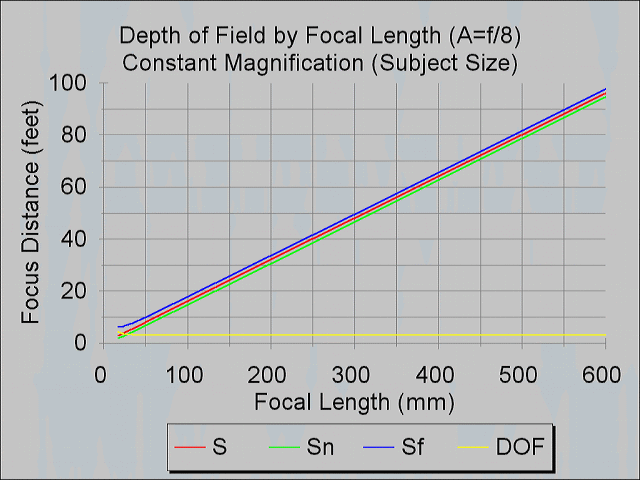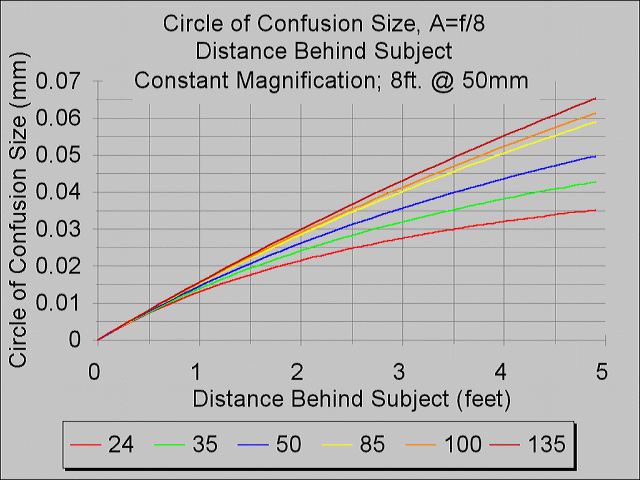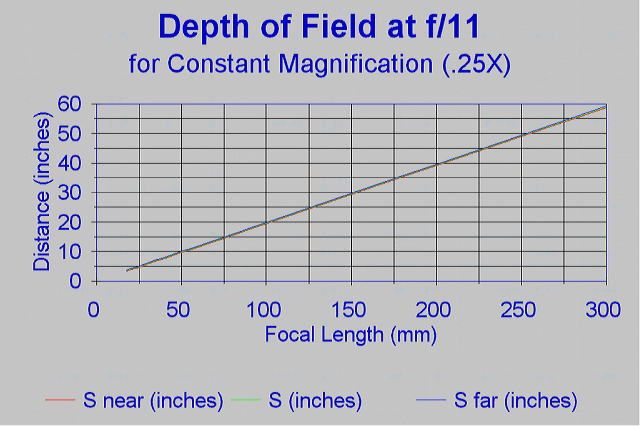| The
Science of Photography |
Text and images Copyright © 2000, 2001 John A. Lind
Depth of Field
This is a "quick and dirty" web page to graphically show what happens to depth of field using various focal lengths with constant subject magnification (i.e. keeping the subject the same size on the film). I've put it together to clarify some common misconceptions about using focal length to control depth of field and how much out of focus regions behind the depth of field will appear in a photograph.
Film is 35mm "small format" with a frame size of 24mm by 36mm. Maximum acceptable diameter for the circle of confusion to determine DOF near and far boundaries was set at 0.025mm (on the film).
The following graphics are charts built using a spreadsheet in Corel Quatro Pro and exporting them into GIF files.
Non-Macro Distances
Magnification for all these charts was set by using a critical focus distance of 8 feet for a 50mm lens. Crictical focus distances for other focal lengths were adjusted to keep magnification the same and aperture was kept constant at f/8. This should represent a typical close non-macro photograph in which DOF control might be desirable.
Depth of Field for Various Focal Lengths while Maintaining Constant Magnification
The following chart shows the cricital focus distance (S), the near DOF boundary (Sn), the far DOF boundary (Sf) and the depth of field "depth" (DOF) as focal length is changed. DOF does not change for constant subject magnification (critical focus). This shows that a focal length change will not increase or decrease the DOF if subject distance is also adjusted to maintain its same size on film (magnification)!

Circle of Confusion Growth Behind Depth of Field
At both the near and far DOF boundaries, the circle of confusion (on film) is at its maximum acceptable diameter. As distance increases beyound the far DOF boundary, the circle of confusion grows. A change in focal length will affect how quickly the circle of confusion diameter grows as distance behind the DOF increases. While a focal length change alone will not affect the depth of the DOF, it will affect how much out of focus the background behind the DOF will appear. The longer the focal length, the more out of focus the background becomes (behind the DOF).

Circle of Confusion Size at "Infinity"
The curves showing circle of confusion growth for a particular focal length are not straight lines. They are cuves and are asymptotic to a distance of "infinity." If the limit is taken with the DOF equations for the circle of confusion size at an infinite distance the sizes at which these curves for various focal lengths converge can be found. This represents the maximum at which a very, very distant background can be rendered out of focus for a given aperture and subject magnification. It also reinforces the concept that while the DOF depth itself cannot be affected by only a focal length change, the out of focus region can be, and the more distant the background is behind the DOF, the more out of focus it will appear (relative to shorter focal lengths). This is most likely the source of the misconception that focal length alone can be used to influence DOF.

Macro Distances
The question may arise that these charts are interesting for relatively close subject material at non-macro distances, but what happens at macro distances. The following charts use a constant magnification of 0.25X of subject size on the film (i.e. 1/4 life-size subject image at the film plane). For these charts, an aperture of f/11 was used.
Depth of Field for Various Focal Lengths while Maintaining Constant Magnification of 0.25X
The following chart shows how DOF remains constant regardless of focal length selected if magnification is held constant for a 1/4 life-size (on film) macro-photograph. Subject (critical focus) distance is now in inches instead of feet.

Circle of Confusion Growth Behind Depth of Field
As with the non-macro distances, the circle of confusion does grow at different rates behind the DOF far boundary depending on focal length selected. As with non-macro magnifications the growth is non-linear and focal length can be selected to influence how much out of focus a distant background behind the DOF will appear. I have shown distance behind the DOF in centimeters (versus inches).





